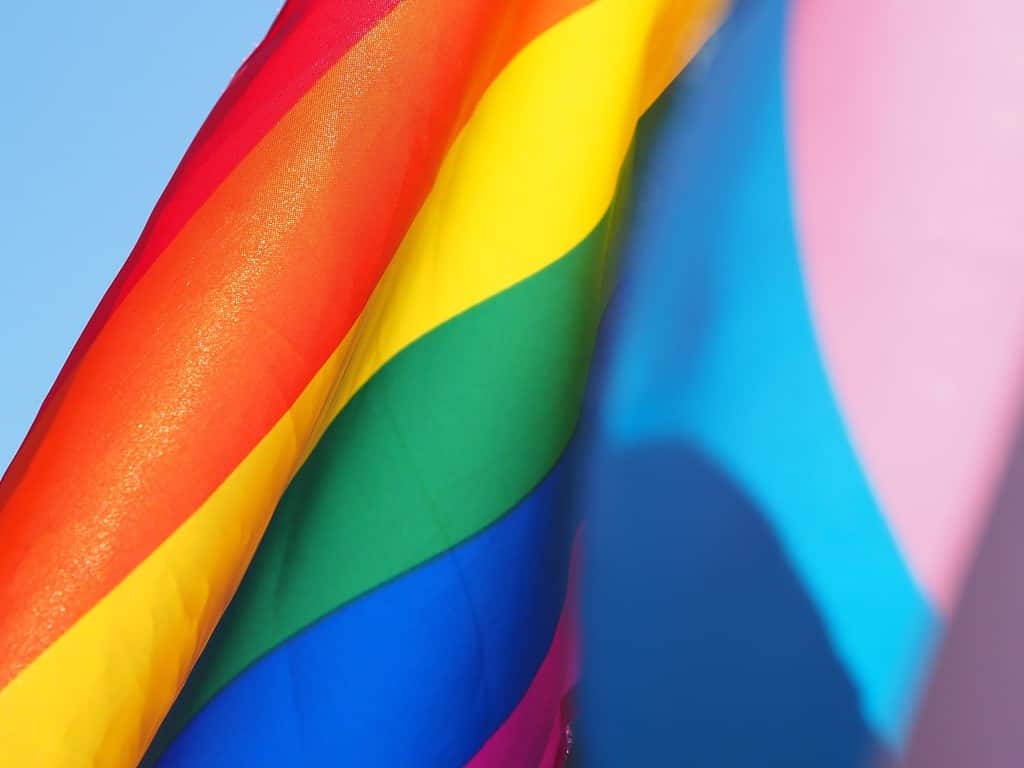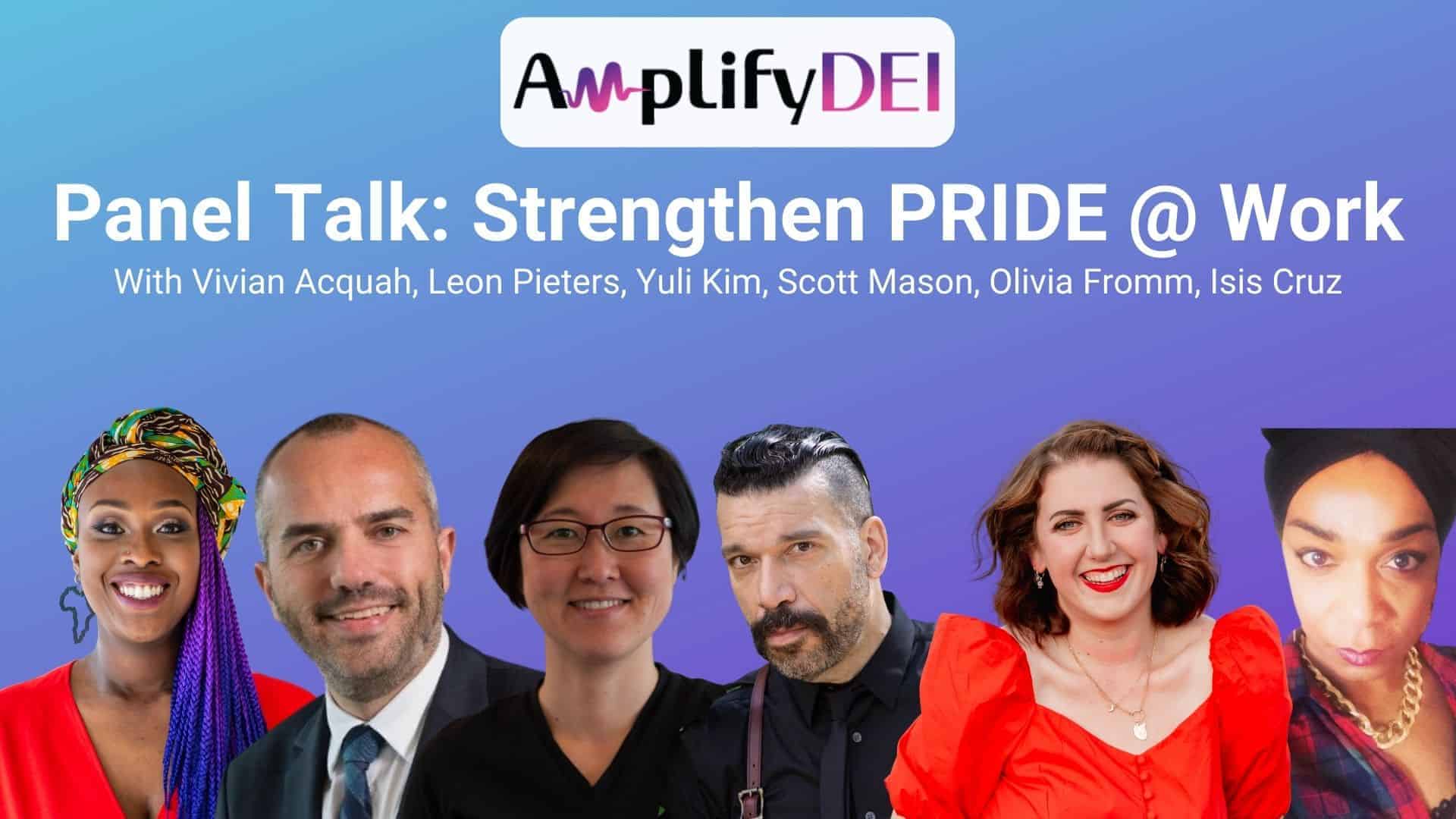Please take a moment to imagine a world where every person feels safe and comfortable in their workplace. And that every workplace was a space they could show up to as their authentic selves, valued and heard.
While strides have been made in many workplaces around the world, the unfortunate reality is that many members of the LGBTQ+community still do not feel this way, that is why this conversation is about PRIDE at work.
Disclosure: This post contains affiliate links. If you click through and make a purchase, I’ll earn a commission, at no additional cost to you.
Amplify DEI Summit
The Amplify DEI Summit, held in September 2021, was designed to address just this:
- How can we create a world where Diversity, Equity, and Inclusion (DEI) are at the forefront in the workplace?
- What role does leadership have in this?
- What are practical steps to make LGBTQ+ representation real and effective?
The first panel discussion was with five leaders in this space:
- Leon Pieters, Global Consumer Industry Leader at Deloitte (He/Him);
- Yuli Kim, Learning and Development Program Manager at Workplace PRIDE Amsterdam (She/Her);
- Scott Mason, Leadership Coach, and Speaker (He/Him);
- Olivia Fromm, Regional Diversity and Inclusion Co-Chair at Indeed (She/Her);
- Isis Cruz, Performing Artist and Designer (She/Her).
These panelists sat down with host Vivian Acquah (She/Her) to discuss why PRIDE, diversity, equity, and inclusion are important in the workplace and how to move towards it practically.
Panel Talk Strengthen PRIDE @ Work

Here are some of the key takeaways from the conversation.
Why PRIDE, Diversity, Equity, and Inclusion Matter
The panel did not spend much time discussing the obvious: diversity, equity, and inclusion matter because people matter. We are starting this conversation with the fundamental truth that all people deserve inclusion, respect, and safety. Instead, the panel focused on why PRIDE at work is essential in the workplace and why people should care about diversity, equity, and inclusion in professional spaces.
The panelists discussed a variety of reasons why people should care about PRIDE at work:
- PRIDE at work is important to create safe work environments: Yuli Kim shared: Creating a safe environment is the baseline standard for any workplace. It’s a human right to have space to conduct your work and business safely. So, if members of the LGBTQ+ community feel that they are not welcomed or accepted, at best, or threatened, at worst, how can they be safe? PRIDE at work creates safe spaces for LGBTQ+ employees to continue to do their jobs without fear of negative repercussions because of who they are.
- PRIDE at work brings kindness, positivity, and hope: PRIDE is centered on authenticity and being true to yourself—a message of hope and positivity. Any workplace will benefit from more of this! It also creates psychologically safe spaces.
- PRIDE at work bolsters engagement and satisfaction: Creating a psychologically safe space for LGBTQ+ employees will translate into an increased sense of engagement and job satisfaction. So, it’s not only the morally right thing to do, but it makes business sense to create an LGBTQ+-inclusive work culture.
- PRIDE at work signals value to all employees: Creating LGBTQ+ inclusive workplace signals to all employees that they are accepted as their authentic, true selves. It shows anyone who doesn’t fit into the standard mold that they are welcome and encouraged to show up to work with authenticity.
- PRIDE at work helps retain good talent in the workplace: In light of COVID-19 and the move to remote work, employees are realizing more than ever that they can work wherever they want. That gives employees agency to choose companies that value them and embrace diversity, equity, and inclusion. So, there are real consequences for companies who choose not to—they lose out on LGBTQ+ talent, innovation, and creativity in their workplace.
That idea that you missed because you were not fully integrating PRIDE into your operations or your
thinking may keep you from being able to survive. The future demands that PRIDE at work matter.
Scott Mason

How to Celebrate PRIDE in the Workplace
It has become popular in recent years for companies to embrace “rainbow marketing” during the months of June and July, especially. This refers to marketing efforts that show support for PRIDE and the LGBTQ+ community. While in some companies, it translates to a real, positive, LGBTQ+-inclusive work culture, others just use it to virtue signal.
The panel discussed how companies could make authentic, sustainable changes to support PRIDE. Here are some of the top ideas that came out:
- PRIDE is about authenticity: No amount of rainbow marketing matters if it’s not authentic. If it’s just about external appearances, don’t even bother. Leaders need to get the why clear: is this just to score points for being culturally relevant, or do they desire to create real, positive change in their workplace?
- Make LGBTQ+ leaders visible: It’s important that a company genuinely walk the talk and make LGBTQ+ employees and leaders visible in your company. Not only does this convey value to the individual, but it signals externally that your company is a safe place. This will attract talent that also values diversity, equity, and inclusion.
- Distribute resources evenly: Instead of focusing 100% effort and resources during PRIDE Month, spread it out throughout the year. Capitalizing on the visibility of PRIDE during June is beneficial, but there are 365 days in the year where these efforts matter. So, plan carefully and spread your resources out through the year to do PRIDE work.
- Learn from other industries: Some industries (or workplaces) have made huge strides and are welcoming, inclusive, and diverse spaces. One panelist, Isis Cruz, shared her experience in the fashion industry, which is generally an inclusive space that embraces the LGBTQ+ community. She shared how other industries, especially in the corporate world, could take some cues from the fashion industry. Leaders can learn from and be inspired by organizations and companies who are getting it “right.”
First of all, I believe that proud pride is all about authenticity.
So, if you do this only for external marketing, please stop it now.
Leon Pieters
Practical Steps for Leaders
If you are reading this or watching the resources available from Amplify DEI, you are likely looking for ways to make your workplace more inclusive.
The panel discussed some really practical steps for leaders to implement diversity, equity, and inclusion values.
Here are some of their suggestions:
- Start with the introduction: Many of the panelists agreed that the first step is simple—it’s about introducing yourself and your pronouns, inviting others to do the same. This signals a safe environment as well as genuine care for other people’s identity. Learn how to use pronouns in a job interview via Indeed’s video – A New Beginning.

- Be political: One panelist, Scott Mason, shared how so many companies will be quick to align with PRIDE when it’s positive messaging, all skittles and rainbows on social media. But, when it comes to actual social and political issues, they remain quiet, claiming, “We’re not political.” So, Scott’s advice was this: if you really care, get political. Otherwise, there is no authenticity to your PRIDE at work.
- It starts from the top: Leaders need to remember the position of power and influence they hold. Any change that they desire to make in a workplace needs to start from them and be modeled by leadership. Therefore, consider your day-to-day actions—do they reflect your spoken values? How can you better align your values and actions in a way that is clear to employees?
- Have regular PRIDE celebrations: Panelist Olivia Fromm shared how her company Indeed will regularly have PRIDE celebrations or education events. This can be monthly, quarterly, or even more frequent. The point is to continue the conversation in the workplace to keep the energy and momentum going.
- Listen and learn from diverse stories: Leaders should remember that each employee and colleague have a unique story and history. If we all stop to listen and learn, we can embrace the beauty of diversity, be encouraged by it, and let it inspire positive change.
- Know the numbers: Many leaders are convinced by numbers and facts. So, Leon Pieters shared the statistic that people who are not out in their workplace spend 30% of their energy pretending to be someone else. This energy expenditure leads to quicker employee burnout as well. There is untapped value in workplaces that are not safe and inclusive for LGBTQ+ employees.
I think to learn from all the beautiful experiences. Everybody has a history, a story.
And some are painful, and some are really courageous. And by learning and listening,
you can take all this knowledge that has been turned into wisdom and just boost it up and better yourself.
Isis Cruz
Moving Forward: Dreams for the future
After sharing these practical and actionable steps for leadership to create inclusive, diverse, and PRIDE-ful workplaces, our panelists shared some dreams and goals for the future.
They envision a world where there were more LGBTQ+ voices in senior leadership, there was increased education on allyship, increased unity, and progress around intersectionality.
The future is bright; the future offers hope. If we can continue these conversations, express authenticity and honesty, and take actionable steps, real change can occur.
If you are interested in learning more, make sure to check out other resources from the Amplify DEI Summit. Amplify DEI is the Netflix of Diversity, Equity, and Inclusion, full of resources aimed to inspire and educate.
You can check out the website here to gain full access to the DEI training.
Latest Posts
- The Role of Male Allies: A Conversation on Inclusive Leadership and Cultural Intelligence
- How Courageous Leadership Boosts Innovation
- Powerful Employee Resource Groups (ERGs): Driving Organizational Success
- Stripe’s Best Practices for Employee Layoff: A Blueprint for Psychological Safety
- Amplifying People Planet Profit Now!







